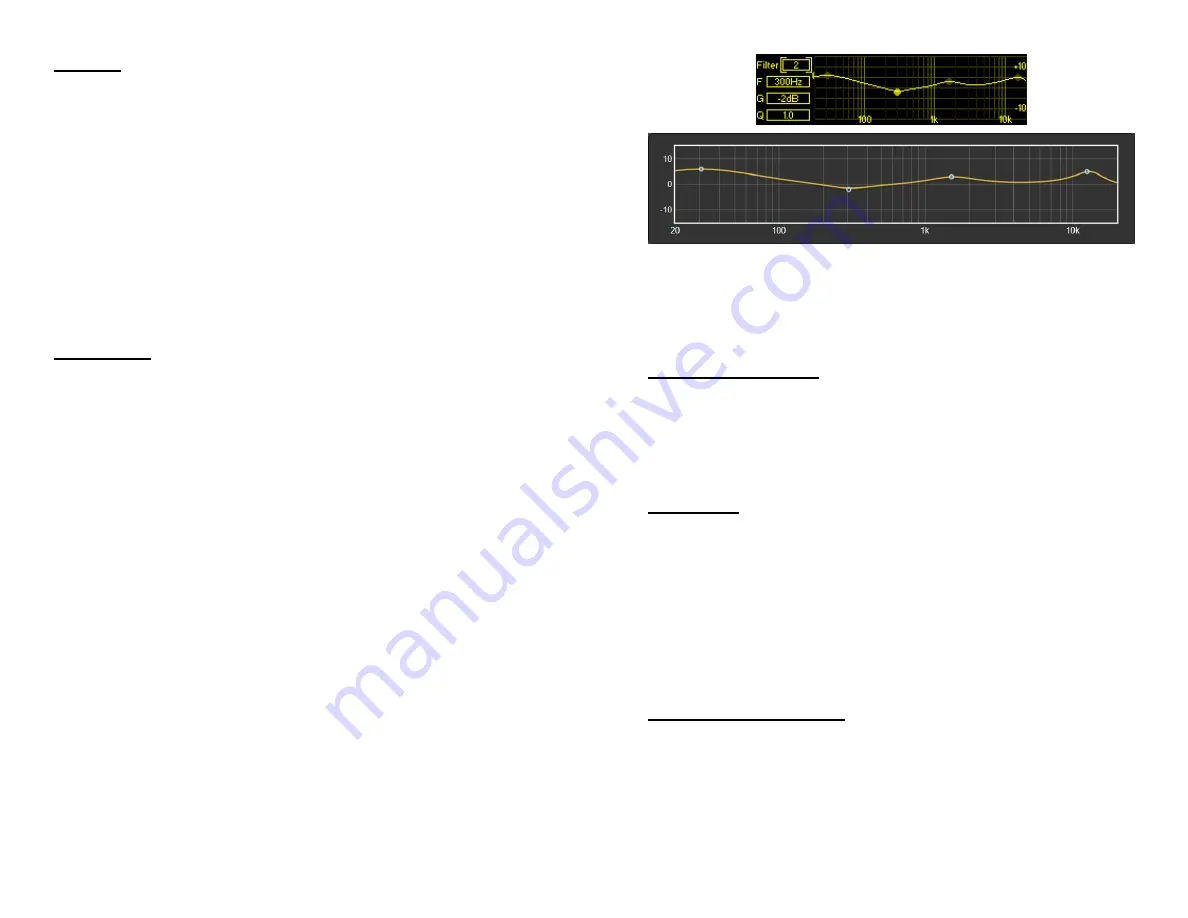
— 17 —
Leveling
The AGC feeds a 2:1 compressor that has ‘syllabic’ response
(like a ‘VU’ meter) to program dynamics. It gives gentle,
unobtrusive dynamic range compression that actually
makes very little difference in program loudness. Leveling
decreases the overall long-term dynamic range of music
programming without ‘pumping,’ and can normalize dialog
among several speakers in a roundtable discussion. Think
of leveling as a fast, ungated AGC.
With
Leveling Drive
turned all the way down to
0dB
, this stage
is essentially out of the circuit and seldom gives any meter
action. Increased Leveling will ‘collapse’ fades at the end of
songs, and extraneous noise in the studio may be more no-
ticeable in the background during pauses in speech.
Equalization
The NOVIA 272 has a four-section parametric equalizer that
can offer quite a lot of control over ‘sonic signature.’
Parametric EQ is not as well-known in the broadcast
environment as it is in the recording studio. This type of
EQ affords variable gain or loss at a selected frequency, not
unlike a single section of the more common graphic equal-
izer. Not only are frequency and gain adjustable here, but
the ‘Q’ (bandwidth) at the selected frequency may also be
varied. Lower ‘Q’ (wider bandwidth) values are most useful
for program equalization. Sharp peaks or nulls are usually
reserved for fixing dedicated-channel problems, ahead of
the final mix, with specific instruments, voices or room res-
onances.
To illustrate the overall effect of the 4-section equalizer
‘bank,’ the frequency and gain of each section are graphical-
ly presented on the front-panel and Web interface menu
screens, and the overall, combined effect of the four sec-
tions is plotted as a graph.
Each section is programmed independently for frequency,
‘Q’ and gain. The illustration at the top of the next page
shows this from front-panel and Web interface perspectives.
The ubiquitous bass boost is centered at 30Hz with a low
‘Q’ of 0.4. The next EQ point reduces ‘tubbiness’ at 300Hz
by a couple of dB. A bit of a ‘presence lift’ at 1.5kHz aids
speech articulation, and a few dB of ‘sparkle’ at the tippy-
top rounds out this profile.
— 18 —
If you are not familiar with parametric EQ, do spend some
time listening to various samples of representative program
material as you put the EQ bank through its paces. Unlike
the more intuitive graphic equalizer, a parametric takes
some getting used to.
Multiband Processing
The multiband processing section of the NOVIA 272 pro-
vides both r.m.s. compression and peak limiting in three
frequency bands. Some multiband setup controls spill-over
from the
Multiband
header into
Limiting
to keep each menu
from getting too cluttered.
Crossovers
Crossovers
are the frequencies that divide the audio spec-
trum into the three processing bands. Filter skirts are se-
cond-order functions offering subtle differences from one
selection to the next. ‘Bass’ frequencies are generally con-
sidered those below 100Hz, so choose the low crossover to
best fit your programming. A high crossover of 2kHz com-
plements the US 75-microsecond FM pre-emphasis charac-
teristic. 3kHz matches the European 50µs curve, but may
give a better-balanced midrange with 75µs pre-emphasis.
‘Master’ and Band Drives
Adjust ‘master’
Drive
to the triband section under
Limiting
/
Triband Drive & RMS/Peak
. This also is where you’ll find the
RMS/Peak
slider that establishes the ratio of r.m.s. to peak
limiting in the three bands. r.m.s G/R (gain reduction) is
shown by the solid or yellow portion of the
LO/MID/HI
G/R
meters, and peak limiting by the floating segment or blue
portion of the bar.




































